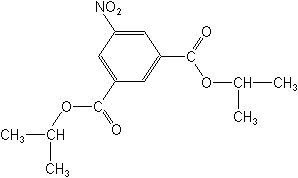-
Common NameNitrothal-isopropyl
-
中文通用名酞菌酯
-
IUPACdiisopropyl 5-nitroisophthalate
-
CASbis(1-methylethyl) 5-nitro-1,3-benzenedicarboxylate
-
CAS No.10552-74-6
-
Molecular FormulaC14H17NO6
-
Molecular Structure
-
Physical PropertiesMolecular weight:295.3g/mol; Physical form:Yellow crystals. Melting point:65℃; Flash point:400℃; Vapour pressure:<0.01 mPa (20 ℃); Partition coefficient(n-octanol and water):logP = 2.04 (pH 7); Solubility:In water 2.7 mg/l (20℃). In acetone, benzene, chloroform, ethyl acetate >100, diethyl ether 86.5, ethanol 6.6 (all in g/100 g, 20℃).; Stability:Stable under normal storage conditions. Hydrolysed by strong alkalis.
-
ToxicologyOral:Acute oral LD50 for rats >6400 mg tech./ kg. Percutaneous:Acute percutaneous LD50 for rats >2500, rabbits >4000 mg/kg. Slight irritation of eyes and mucous membranes (rabbits). Inhalation: LC50 (8 h) for rats >2.8 mg/l. ADI:3.0 mg/ kg.
-
Environmental ProfileEcotoxicology:
Algae: EC50 (96 h) 1.72 mg/l.Bees: LD50 (oral) >100 mg/bee.Daphnia: LC50 (48 h) 2.84 mg/l.Fish: LC50 (96 h) for trout 0.56 mg/l.Worms: LC50 (14 d) 1200 mg/ kg soil.
Environmental fate:
Animals:In rats, following 7 daily oral administrations, c. 85% is eliminated in the urine and c. 12.5% in the faeces within 6 days of the last dose.Soil: DT50 in soil <1-12 d. Adsorption coefficient KA 8.55-136.4, depending on soil type.Plant:Metabolites are 3-carbo-isopropoxy-5-nitrobenzoic acid and 5-nitroisophthalic acid. -
Transport InformationSignal Word:CAUTION; Hazard Class:III(Slightly hazardous)
Porduct NewsMore
Orthosulfamuron boosts sugarcane production, study finds
Glyphosate price plummets 40% in one year in Argentina
Indian govt stops imports of herbicide Glufosinate priced below Rs 1,289 per kg
Carbendazim fungicide wins victory in Brazilian Parliament
Corteva presents new pre-emergent herbicide Linear for sugarcane in Brazil
Picloram Triclopyr Aminopyralid
Revolutionizing disease prevention: BASF launches new rice fungicide Cevya® in China
Thiamethoxam is allowed again in Brazil by a judicial decision
Bayer develops alternative to glyphosate herbicide

 0
0 Subscribe
Subscribe
